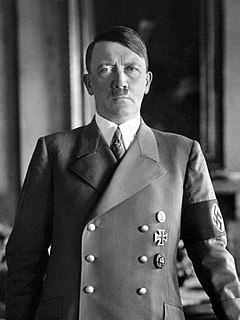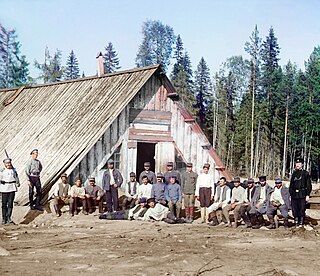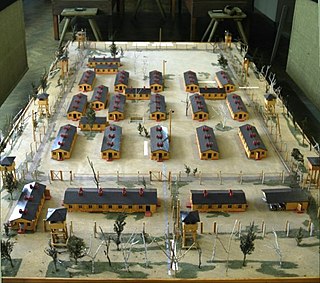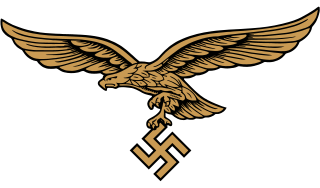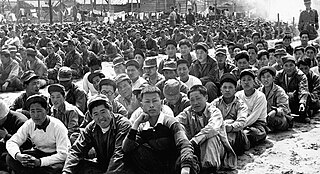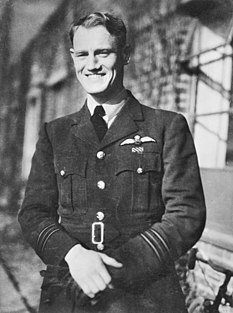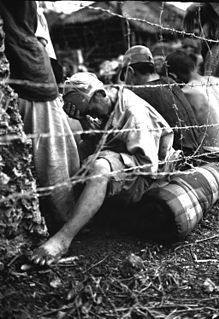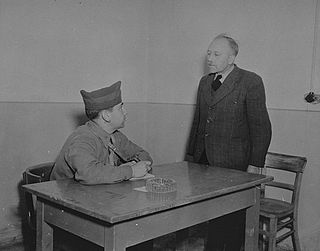| Nationality | Name | Buchenwald number | Notes |
|---|
| New Zealander | Cullen, Malcolm Ford | 78388 | Died 5 September 2002. [16] |
| Lamason, Phillip (Phil) John [17] | 78407 | Senior Officer (Squadron Leader) at Buchenwald concentration camp. Interviewed in the 1994 NFBC documentary, Buchenwald: The Lucky Ones. Portrayed in the History Channel’s 2004 documentary Shot from the Sky. Died 19 May 2012. |
| Australian | Fairclough, Mervyn James [18] | 78427 | Died July 1964, Katanning Western Australia. [19] |
| Gwilliam, James (Jim) Percival | 78423 | Died 11 August 2002. [19] |
| Johnston, Eric Lyle | 78421 | Interviewed in the 1994 NFBC documentary, Buchenwald: The Lucky Ones. Died 25 August 2003. [19] |
| Light, Kevin William | 78381 | Died 19 July 2008. [19] |
| Malcolm, Thomas (Tom) Alexander | 78379 | Died 15 February 2002. [19] |
| Mills, Keith Cyril. | 78405 | Died February 2012, Mackay, Queensland. [20] |
| Mills, Robert (Bob) Neil | 78426 | Died 8 August 1990. [19] |
| Perry, Raymond (Ray) Walter | 78356 | Died 26 November 1997. [19] |
| Whellum, Lesley (Les) Keith | 78442 | Died 23 May 2003. [19] |
| Jamaican | Guilfoyle, Michael (Mike) A. [21] [22] | 78393 | Not located after World War II, but a Captain Michael Guilfoyle flew for Air Jamaica in 1966. [23] |
| Canadian | Atkins, Harold | 78440 | Only Canadian KLB member not located after World War II |
| Bastable, Harry [24] [25] | 78378 | Deceased September 23, 2007 |
| Clark, Don | 78364 | Deceased April 30, 1988 |
| Crawford, John | 78406 | Deceased. [26] |
| Comptom, G.A. Edward | 78434 | Deceased |
| Carter-Edwards, Ed [2] | 78361 | Interviewed in the 1994 NFBC documentary, Buchenwald: The Lucky Ones. Died February 22, 2017 in Ontario Canada. [27] |
| Fulsher, Frederick W. [28] | 78418 | Deceased |
| Gibson, William (Bill) R. [29] | 78394 | Addressed the Canadian Standing Committee on Veterans Affairs about Buchenwald, in February 2000. Deceased |
| Grenon, Leon (Leo) T. [30] | 78438 | Died September 1994 |
| Harvie, John D. [31] | 78412 | Co-wrote the book "Missing in Action" about Buchenwald. Died January 5, 2011. |
| Head, Les [29] | 78430 | |
| Hetherington, Stanley (Stan) [30] | 78436 | |
| High, Dave | 78422 | Interviewed in the 1994 NFBC documentary, Buchenwald: The Lucky Ones. |
| Hodgson, Thomas (Tommy) R. | 78424 | Deceased |
| Hoffman, Charles Richard (Dick) [32] | 78429 | Deceased |
| Kinnis, Arthur (Art) G. [33] | 78391 | Co-wrote the book "168 Jump into Hell" about Buchenwald. Died January 20, 2011 in Victoria, British Columbia. [34] |
| Leslie, Donald (Don) E. [35] | 78404 | Interviewed in the History Channel’s 2004 documentary Shot from the Sky about Buchenwald |
| McLenaghhan, J. Ralph | 78373 | Deceased |
| Prudham, James E. (Pep) [29] | 78374 | Died 2000 in Scarbrough Ontario. [36] |
| Scullion, Patrick [30] | 78395 | Deceased |
| Shepherd, Ernest G. | 78372 | Deceased |
| Smith, James A. [29] | 78428 | Died July 29, 2013 |
| Sonshine, E.R. (Joseph) [21] | 78343 | Died March 13, 2005 in Toronto, Ontario, Canada. |
| Walderam, Willie A. | 78402 | Wrote the poem, "A Reflection", about KLB and Buchenwald. Deceased |
| Watson, Earl Carruthers [32] | 78431 | Deceased |
| Willis, Calvin E. | 78342 | |
| British | Angus, Jack W. | 78390 | Not located after World War II |
| Barham, Leonard P. [37] | 78432 | Not located after World War II |
| Baxter, Stuart | 78384 | Not located after World War II |
| Bennett, Geoffery | 78344 | Teacher at Caludon Castle School Coventry |
| Blackham, Thomas Henry (Tom) [38] | 78380 | Senior British officer (Flight Lieutenant) at Buchenwald. President of the KLB Club Great Britain chapter. Interviewed in the 1994 NFBC documentary, Buchenwald: The Lucky Ones. Died 6 April 2003. [39] |
| Booker, Stanley Albert [40] | 78370 | Co-wrote the book "168 Jump into Hell" about Buchenwald |
| Bryden, Robert (Bob) | 78365 | |
| Chapman, E.W. (Ken) [17] | 78409 | Died 29 June 2008 in Sussex. |
| Chinn, Albert J. [37] | 78433 | Not located after World War II |
| Clark, John | 78385 | Not located after World War II |
| Davis, Eric | 78346 | Deceased |
| Dowdeswell, Philip | 78410 | Not located after World War II |
| Eagle, Douglas [35] | 78403 | Deceased |
| Fernandez, John Joseph [41] | 78352 | Died December 1992 |
| Gould, Terrance [40] | 78386 | Not located after World War II |
| Harper, Robert | 78414 | Not located after World War II |
| Heggarty, Patrick W. [18] | 78420 | |
| Hemmens, Philip D. [42] | 78383 | Died in Buchenwald from septic aenemia, rheumatic fever and pneumonia on 18 October 1944. |
| Hughes, Ronald R. | 78347 | |
| Jackson, Edgar | 78392 | Deceased |
| Jordin, Douglas F. [21] | 78341 | Not located after World War II |
| Joyce, Reg W. [35] | 78401 | |
| Kay, William [28] | 78400 | |
| Leverington Ronald (Ron) L. [35] [43] | 78382 | Still alive in November 2011. [44] |
| Lucas, Lewis J. | 78389 | |
| MacPherson, Alexander J. | 78435 | Not located after World War II |
| Marshall, Wilfred | 78417 | Not located after World War II |
| Measures, Dorak K. | 78413 | Deceased |
| Mutter, Neville E.S. | 78375 | Died March 2001 |
| Nuttall, Cyril Worsley [41] | 78366 | Died November 1990 |
| Osselton, John N. [40] | 78371 | Not located after World War II |
| Peirson, Frank | 78362 | |
| Percy, Douglas C. | 78411 | Deceased |
| Phelps, Edward K. | 78419 | |
| Reid, John D. | 78387 | Not located after World War II |
| Robb, Ian A. [45] | 78415 | |
| Rowe, Andrew [24] | 78408 | Not located after World War II |
| Salt, Frank | 78345 | Not located after World War II |
| Sharrate, William D. | 78397 | Not located after World War II |
| Spierenburg, Splinter Adolph (Dutch) | 78443 | Dutchman flying for the RAF. [46] Spoke fluent German and regularly acted as an interpreter for Lamason. Not located after World War II, but a P/O Splinter Adolphe Spierenburg (born 17 May 1920 in the Hague) who joined the RAF in 1942, shot down over France in May 1944, and was subsequently sent to a concentration camp, died April 1997, in England. [47] |
| Stewart, James (Jim) A. | 78416 | Interviewed in the 1994 NFBC documentary, Buchenwald: The Lucky Ones. |
| Taylor, Peter D. | 78425 | |
| Taylor, Ralph John (Bob) | 78376 | Designed the KLB Club pin. Interviewed in the 1994 NFBC documentary, Buchenwald: The Lucky Ones. |
| Vinecombe, Frederick S. [29] | 78377 | Celebrated his 103rd birthday in 2017, alive and well in 2018 |
| Ward, John D. | 78396 | Not located after World War II |
| Watmough, George F. [30] | 78439 | Not located after World War II |
| Wesley, Laurice | 78399 | Not located after World War II |
| Williams, Llewelyn | 78437 | Not located after World War II |
| American | Alexander, William | 78287 | Deceased |
| Allen, Roy | 78357 | Co-wrote the book, "In the Shadows of War" about Buchenwald. Main character in the History Channel’s 2004 documentary Shot from the Sky. Died 1991 |
| Appleman, Stratton M. | 78314 | Deceased |
| Bauder, Warren F. | 78196 | Interviewed in the History Channel’s 2004 documentary Shot from the Sky about Buchenwald |
| Beck, Levitt C. | 78286 | Died in Buchenwald from purulent pleurisy on the evening of 29 November 1944. |
| Bedford, Richard L. | 78283 | |
| Bowan, Chasten (Chas) E. [48] | 78336 | Interviewed in the History Channel’s 2004 documentary Shot from the Sky about Buchenwald. Died December 30, 2016. |
| Brown, Robert W. | 78295 | |
| Bozarth, James Walter | 78340 | Deceased |
| Carr, Frederick W. | 78318 | Deceased |
| Chalot, John A. | 78278 | |
| Chapman, Park | 78284 | Deceased |
| Chessir, Douglas | 78285 | |
| Coats, Basil A. | 78308 | Deceased |
| Coffman, J.D. | 78319 | |
| Cowan, Frank Kirby | 78271 | Died December 23, 2009 |
| Crouch, Marshall Jr. E. | 78277 | Deceased |
| Dauteul, Donat F. | 78324 | |
| Dearey, Ralph W. | 78316 | Deceased |
| Denaro, Joe | 78269 | |
| Duncan, James H. | 78300 | Deceased |
| Edge, William L. | 78267 | Died 1996 |
| Fix, Karl Ellsworth | 78313 | Deceased |
| Fore, James W. | 78349 | |
| Freeman, Elmer (James) C. | 78359 | Died 2 August 2012, Niceville, Florida [49] |
| Friel, Edward J. | 78309 | |
| Granberry, William L. | 78312 | Deceased |
| Hanson, John T. | 78280 | Not located after World War II |
| Hastin, James (Jim) D. | 78354 | Interviewed in the 1994 NFBC documentary, Buchenwald: The Lucky Ones. Died February 2005 |
| Heimerman, Lawrence A. | 78334 | Deceased |
| Hilding, Russ D. | 78326 | |
| Hoffman, Robert B. | 78350 | Deceased |
| Horwege, Glen L. | 78281 | Deceased |
| Horrigan, Roy J. | 78321 | |
| Hunter, Harry F. | 78337 | |
| Johnson, Robert T. | 78272 | |
| King, Myles A. | 78279 | |
| Larson, Merle E. | 78363 | Senior US Officer (Captain) at Buchenwald. Died 1998. |
| Little, Bruce S. | 78301 | |
| Ludwig, Everett F. | 78339 | Deceased |
| McClanahan, John H. | 78348 | Deceased |
| Martini, Frederic C | 78299 | Active in KLB, VFW, POW groups. Deceased 1995 in Bradenton, FL. |
| Masters, Lovell O. | 78290 | Deceased |
| Mauk, William E. | 78298 | Deceased |
| McLaughlin, Daniel (Whitey) G. | 78338 | |
| Mikel, George | 78266 | Deceased |
| Mitchell, Gerald E. | 78307 | |
| Moser, Joseph (Joe) [50] | 78369 | Interviewed in the 1994 NFBC documentary, Buchenwald: The Lucky Ones. Co-wrote the book "A fighter pilot in Buchenwald" about Buchenwald. Interviewed in the History Channel’s 2004 documentary Shot from the Sky about Buchenwald. Died December 2, 2015 in Ferndale, Washington |
| Pacha, Arthur M. | 78288 | |
| Paxton, S. Keith | 78320 | |
| Pecus, Steve | 78315 | Deceased |
| Pederson, J.W. (Charles) | 78351 | Died 23 July 1986 |
| Pennel, Sam | 78289 | Deceased |
| Petrich, Michael R. | 78325 | Interviewed in the History Channel’s 2004 documentary Shot from the Sky about Buchenwald. Died April 23, 2006 (Long Beach, California). [51] |
| Phelps, Byron F. | 78331 | Deceased January 10, 2012 |
| Pelletier, Arthur J. | 78335 | |
| Powell, William (Bill) | 78296 | Original President of the US chapter. Interviewed in the 1994 NFBC documentary, Buchenwald: The Lucky Ones. Died September 10, 1997 (Bella Vista, Arizona). [52] |
| Reynolds, Leo J. | 78292 | |
| Richey, G. Thomas | 78317 | Died 2 June 2004 |
| Ritter, Edwin W. | 78311 | Spoke Polish. Deceased. |
| Robertson, Charles William | 78327 | Died 25 October 2005 |
| Rynerd, William H. | 78358 | |
| Salo, Laurie H. | 78270 | Deceased |
| Smith, James W. | 78323 | Deceased |
| Scharf, Bernard T. | 78353 | Spoke German. Not located after World War II. |
| Scott, George W. | 78330 | Not located after World War II. |
| Shearer, Donald R. | 78332 | |
| Straulka, Paul A. | 78268 | Deceased |
| Suddock, Dwight E. | 78273 | Deceased |
| Sypher, Leroy Henry | 78276 | Deceased February 4, 2006 |
| Thompson, Warren A. | 78329 | |
| Vance, Ira E. | 78360 | Deceased |
| Vallee, Edward | 78293 | Deceased |
| Vincent, Edwin H. | 78310 | Deceased |
| Vratney, Frank | 78328 | Spoke Czech or Slovak. |
| Ward, Robert | 78355 | |
| Watson, John Paul | 78333 | |
| Williams, W.J. | 78294 | |
| Wilson, Paul J. | 78297 | Deceased |
| Wojnick, Ray J. | 78367 | Deceased |
| Zander, Arthur E. | 78368 | Deceased July 15, 2009 |
| Zeiser, James | 78322 | Deceased |



